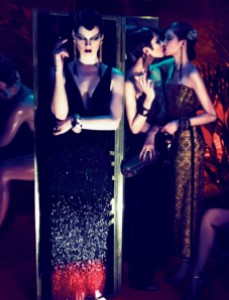Serge Lutens describes Serge Noire as a phoenix rising from the ashes.  Perhaps. I see it more as a cloven beast, with “cloven” referring not only to the cloves that make up such a large part of its character but also to the traditional definition of the word: split in two. To me, Serge Noire is Janus, that ancient Roman god with two faces and the god of beginnings and ends. In common, modern parlance, you might say that Serge Noire is slightly bi-polar.
Perhaps. I see it more as a cloven beast, with “cloven” referring not only to the cloves that make up such a large part of its character but also to the traditional definition of the word: split in two. To me, Serge Noire is Janus, that ancient Roman god with two faces and the god of beginnings and ends. In common, modern parlance, you might say that Serge Noire is slightly bi-polar.
A good starting point in discussing Serge Noire is the Lutens’ press release. As provided by BoisdeJasmin, it states:
The ether of ashes… A phoenix, the mythical bird of legend burns at the height of its splendour before emerging triumphant, reborn from the ashes in a choreography of flame, conjuring the shapes of yesterday in a dance of ashes. The swirls of oriental grey enrich the twilight with depth and intensity while windswept memories hint at the beauty of transformation. An ode to everlasting beauty under cover of night’s rich plumage.
The Lutens website omits the poetry, and simply says:
nothing can capture this scent’s spirit better than subtle “snapshots” from the past, like a forgotten glove lying on an antique chair.
Incense stirred by the smell of burnt wood.
The full, complete notes for Serge Noire are hard to pinpoint with any uniform, agreed-upon accuracy. The consensus on the basic elements seems to be: cloves, cinnamon, patchouli, incense and “dark woods.” However, Perfume Shrine also referenced “elemi,” a spicy, peppery and citrusy resin. Fragrantica gives the notes as: “patchouli, cinnamon, amber, woody notes, incense, clove, spices and ebony wood.” And, yet, most think that there must be some cumin in there too. I also see repeated references to grey ash, labdanum/cistus, benzoin and castoreum. (Castoreum essentially comes a beaver’s anal sacs and has been used in such famous fragrances as Shalimar, Jicky, Cuir de Russie, Antaeus, Amouage Epic and more. See, the Glossary for a full definition and more details.) I’ve even read a few comments that mention gunpowder too!
I was a bit terrified to try out Serge Noire because of the sheer forcefulness of the negative reviews. This is a fragrance that seems to engender extremely intense reviews, but the positive ones on places like Basenotes are nowhere as vehemently extreme as the negative ones. (If you’re ever bored, I suggest reading some of the comments. At the very least, they’re really amusing.) To give you an idea of some of the Basenotes comments:
- “Sacré bleu, Serge! Why did you market this horror?”
- “[W]hy did I buy this? just like chewing tin foil”
- “It starts out like a punch in the face and a savage cauterizing of the ol’factory with several murderous spices. Then ATTACK OF THE CLOVES and suddenly your feet are raised high above your head as you are hoisted in the dental chair preparing for root canal treatment. This surely must be somebody’s idea of a practical joke.”
- “Absolutely, incredibly and horribly foul. One of the most disgusting things I have ever smelled in my life.”
- “Pure evil!”
An even more alarming review came from NST where the perfume was compared to a potpourri of ingredients whose recipe included, just in small part, the following:
- 50 pieces of charred cassia bark (the bark should be blackened and retain only the most rancid traces of oil and odor);
- Ten 1/8-inch slices of Swiss cheese;
- Chain-gang T-shirt bits (with scissors, cut out and save the stained, armpit areas (bits) of 25 sweaty T-shirts that have been worn at least 10 hours on a 90-100 degree day;
- One large box of moth balls, roasted (roast on a grill in the open air while wearing a HEPA-filter mask); and
- 10 handfuls of singed hair (… for pre-singed locks, visit the worstsalon in your area and obtain fall-out from recently botched dye jobs, hair-straightening sessions, permanents, etc.).
Finally, pour the contents of three bottles of Angostura bitters and two bottles of grenadine into the bucket, top off with more salt, and let the mixture ‘rest’ in the (covered) bucket — in a dark and dank place — under lock and key — for at least two weeks.
To be fair, there are a lot of extremely passionate, gushing, postive reviews for Serge Noire, with its fans calling it the best Lutens fragance “in years” and with others applauding the genius of the “nose” behind its creation, the very famous Christopher Sheldrake. Some of those — like Perfume Shrine‘s review — wax so poetically, they are almost other-worldly. In fact, the latter review seemed much more like existentialist tract on philosophy and poetry than an assessment of mere perfume.
Nonetheless, I’ve found the horror outweights the poetry when it comes to reactions. There are also constant references to “BO” (body odor) and sweat which I found alarminng. But when Smelly Thoughts — a blogger who adores niche fragrances that are somewhat avant-garde or extreme — called it “hideous” just a few days ago, I really paled a little. So, it’s not surprising that I put it on with great trepidation. And I must say, I hardly find it to be “pure evil.”
I loved the opening spray of Serge Noire, but I wonder how much of my reaction stemmed from enormous relief rather than actual love. My initial notes actually read like this: “CLOVES! No sweat, thank god! Ooops… sweat.” As someone who cooks extensively, I have issues with cumin and, to me, it often evokes an impression of dirty, sweaty socks with the rancid, fetid body odor of someone who has never understood the joys of soap and water. Serge Noire definitely evoked “BO.” But, to my surprise, there was just a fleeting note of sweat in the opening salvo. Instead, I was strongly reminded of the smell of a leather saddle, slightly damp and with a touch of the horse or rider’s sweat. There was also a fascinating mix of camphor to counter the sweetness of the clove and what almost seemed like star anise. There is a faint touch of something medicinal that vaguely brings to mind Tiger’s Balm muscle rub, but it’s a sweet note as compared to the sharply metallic, cold, screechy medicinal accord in some oud fragrances. The camphor is not a surprise;Sheldrake has used it before in fragrances for Serge Lutens. Tubereuse Criminelle is perhaps the most well-known for that accord but there, the camphor mixes with a green floral scent, not with something as sweet as cloves and cinnamon.
I was so enchanted by the warmth of the cloves that I actually added another two sprays (though small in size) to my other arm. The cloves are a bit surprising in their expression on my skin; they’re not sharp but deeper, warmer and more well-rounded than I had expected. Some of the Lutens fragrances can be a bit cacophonous in their opening but Serge Lutens surprises me by being much tamer than the ferocious, hideous beast of the reviews.
I was really enjoying the fragrance thus far and it made me feel rather Christmas-y in some ways. Yet, the strongest and most constant memory that it evoked was Estée Lauder’s legendary Cinnabar, that famous 70s cousin to YSL’s Opium. The cloves in Serge Noire are, on my skin, much sharper than the more cinnamon-predominant Cinnabar, but they definitely share similarities to my mind and not solely because they are powerhouse scents centered around cinnamon and cloves. No, there is definitely a slightly retro feel to Serge Noire, though it’s a modern take on retro with the cinnamon.
On MakeupAlley, one commentator said they smelled “deadly hot pepper” but I don’t see it. Another said that she had a very strong impressed of ketchup mixed with a spicy BO scent. I definitely agree on the ketchup, but it’s a very vague, tenuous and fleeting impression, and it’s really due to the cloves and patchouli. Others reference the frankincense but to me, in the first two hours, it’s more patchouli. If it is frankincense that creates that peppery, smoky, dirty black scent, then it’s a very different type of frankincense than the one in Chanel’s Coromandel. (Reviewed here.) No, I think it’s more patchouli than frankincense, though Perfume Shrine (linked up above) seems to ascribe the peppery, spicy notes to a resin called “elemi.”
Either way, the linear nature of the fragrance in the early hours is a slight disappointment. The heart of cloves, cinnamon and camphor is just too strong of a constant thread. Yes, there is incense and patchouli, but it’s hard to separate them at times. Serge Noire is an extremely well-blended fragrance — so much so that the patchouli, cloves, cinnamon, and incense blend together in an extremely harmonious whole. I would have preferred something that morphed much more. And it does, later, change a little but not by much.
I thought Serge Noire was a very warm fragrance which is why reviews referencing its cold, “austere” nature were a little confusing at first glance. Austere? Is it the incense? Perfume Shrine’s review noted a definite and almost overwhelming impression of old, slightly dusky, byzantine Orthodox churches. That was my feeling for Chanel’s Coromandel, but not for Serge Noire. Others have said it’s the holiest of all holy incense fragrances, but I don’t agree with that either because it would seem to imply that Serge Noire is primarily an incense fragrance. I think it’s primarily a clove one. Which brings me to another point: cinnamon. There is definitely cinnamon here but it’s true presence comes later. To me, cinnamon is a much milder, softer, gentler and more feminine scent than cloves which is hot, not merely warm. It’s sharper, dirtier, sometimes slightly more acrid or astringent, but always more forceful.
Starting on the second hour, another note starts to rear its head. It’s the smell I had dreaded upon initially reading reviews for the perfume. It’s the smell of sweat and body odor. If this were a horse race, the clove chestnut that had led the pack, followed closely by the cinnamon sorrel, have now faded from the leader spot. They’re being edged out by a faint nose by the black patchouli stallion and its incense twin. However, coming up from the rear, is the sweaty horse whose saddle is slick with its earthy nature. And the dark woods all around the racetrack are starting to gently sway in the breeze, as if to participate in the events before it.
The award-winning, incredibly brilliant expert, Elena Vosnaki, at Perfume Shrine has a polar opposite impression:
Initially dry and spartan with the flinty, camphoreous aspect of gun powder comparable to Essence of John Galliano for Diptyque, ashes to ashes and snuffed out candles, Serge Noire by Lutens assaults the senses with the intense austerity of real frankincense and elemi. The impression is beautifully ascetic, hermetic, like an anchorite who has dwelled in a cave up in the rough mountains with only the stars as his companion in the darkest pitch of the night: the “noire” part is meditatively devoid of any ornamentation, eclipsing any pretence of frivolous prettification. The surprising transparency is evocative of the Japanese Kodo ritual rather than the denser cloud of Avignon. Those who are unitiated to the wonders of Lutens might coil away with trepidation and apprehension at this point, but much like the alarming mentholated overture of Tubéreuse Criminelle, this subsides eventually, although never quiting the scene completely.
And yet behind the caustic and mineral masculinity, a hopeful ascent of a feminine trail of lightly vanillic, ambery benzoin and sweet spice is slowly, imperceptibly rising after half an hour; like a subtly heaving bosom draped with Japanese garments or the curvaceous calligraphy of thick black ink on gaufre paper of ivory or creamy skin. It is then when cistus labdanum provides an erotic hint of sophisticated elegance in Serge Noire while the emergence of sweet spice, a touch of cinnamon, gives a burnished quality of black that is slowly bleeding into grey.
The ashen ballet in the flames, the swirls of oriental grey sing an ode to everlasting beauty, beauty under the cover of night’s rich plumage.
Perfume may be subjective, but there are few more respected experts in the perfume world than Elena Vosnaki, so her impressions of Serge Noire make me wonder why I’m getting such a different vibe. To my huge relief, Perfume Posse resolved my dilemma and made me realise that we’re BOTH right: “it just has a lot of facets that go in and out – dust, warmth, cool incense, woods.” It is coldly austere, but also red hot. (Actually, “red hots,” the cinnamon candies, are a big note in the perfume’s dry down.) It’s all incense (or, for Grain de musc, “a sizzling succession of resins”), or it’s dental chairs of camphor and stale body sweat.
In short, Serge Noire is a bit schizophrenic. It is simultaneously exactly like my review, and like that of the Perfume Shrine. Hot and dusty, or austere, cold and full of the grey ashes of a dying fire — it is both things at once. Or, to go back to Janus, it wears two faces. Remember all that Lutens PR and the seemingly over-the-top, marketing flights of fancy? Well, I actually get it now. The phoenix rises from the dusty, cold ashes of death, reborn as a fiery, powerful, red-hot swirl of light and warmth, before
ashes of a dying fire — it is both things at once. Or, to go back to Janus, it wears two faces. Remember all that Lutens PR and the seemingly over-the-top, marketing flights of fancy? Well, I actually get it now. The phoenix rises from the dusty, cold ashes of death, reborn as a fiery, powerful, red-hot swirl of light and warmth, before  flying off above the woods and into the cold night. It not only true, but it’s actually is pretty genius how the marketing so captured what seems to be a very intentional and deliberate ethos behind this perfume. So intentional that it reportedly took ten long years to create this scent’s contradictory nature, a scent that is Serge Lutens’ own personal favorite.
flying off above the woods and into the cold night. It not only true, but it’s actually is pretty genius how the marketing so captured what seems to be a very intentional and deliberate ethos behind this perfume. So intentional that it reportedly took ten long years to create this scent’s contradictory nature, a scent that is Serge Lutens’ own personal favorite.
For all of Serge Noir’s vociferous opening, it definitely quietens down after about two hours. And four hours in, it’s very close to the skin and almost…. well, I wouldn’t say “subtle” but it’s definitely been tamed. It’s quiet amber and spice with the frankincense or patchouli just barely shimmering in the light. It’s cinnamon and resin. And sweat.
I did mention the rise of the sweat factor, didn’t I? Well, it becomes quite prominent in the dry-down, though I should emphasize again that the perfume is extremely close to the skin at this point. Still, after about five or six hours, I would catch a faint but definite smell of body odor. I’d been doing other things, forgotten about the perfume (yes, that actually is possible at this point) and, for a fleeting moment, thought to myself, “God, is that me?”
I like Serge Noire a lot more than I had expected to and, indeed, found the opening quite enchanting. But, after some reflection, that body odor element combines with a few other things to make this a bottle I wouldn’t buy. (If given to me, however, I’d certainly wear it on occasion. I think….) It’s a fascinating fragrance and, on me, certainly wasn’t as “hideous,” “evil,” “horrific” and venomous as the critical reviews had led me to expect. If you’re a perfume junkie with a curious streak, I would definitely recommend buying a small vial for $3.99 at Surrender to Chance just to see what all the fuss is about. If you’re a fan of cinnamon and clove, I’d advise the same. And, honestly, you may really like it; there are certainly plenty of people who do. For everyone else, however — particularly those of a less inquisitive, bold or fool-hardy nature, or those who like the “fresh, clean” scents — I would recommend staying far, far away.






